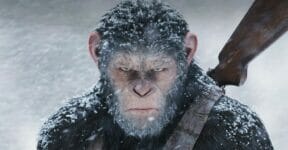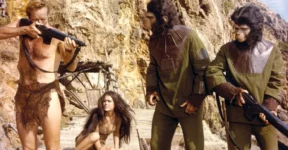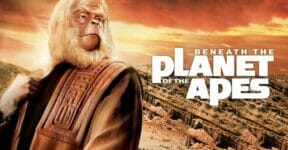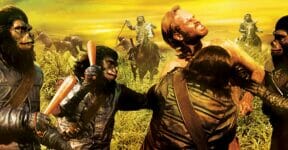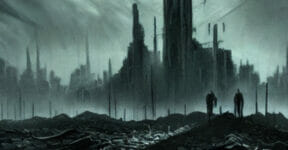Screenwriter Paul Dehn was on board for the third Planet of the Apes film. Producer Arthur P. Jacobs, despite having said there would only be one sequel, was pleased with the commercial success of the previous installment that he decided to make another title, Escape from the Planet of the Apes.

The previous film ends with Taylor detonating a nuclear bomb to destroy the entire planet. Everyone, humans and apes, are supposed to be dead, so Paul Dehn came up with a time warp idea to keep the franchise alive. In a lucky plot twist, friendly chimpanzee scientists Dr. Zira, Dr. Cornelius, and Dr. Milo manage to repair Taylor’s damaged spaceship and escape the planet. It happens just in time before the nuclear blast and electromagnetic pulse render the vehicle useless.
Credit where credit is due: screenwriter Paul Dehn recycles the time-warp idea (used as the framing premise in the first and second films) to send the apes from the distant future back to present-day America. The third film is therefore set at a time when humans reign supreme and talking apes are considered threats to humanity. A direct role reversal is in order. Time dilation practically restarts the series all over again. With an excellent screenplay in hand, director Don Taylor creates an effective introduction to the new character, Caesar, and sets the backstory right for an all-out conflict between humans and apes.
The timeline in Escape from the Planet of the Apes is set on present-day Earth in the 1970s. Military guards secure a perimeter around a site on a Californian beach where a spaceship has just landed. The vehicle looks familiar because it is the same space shuttle used by Taylor and his crew. To the people’s amazement, the pilots are not astronauts wearing ANSA (a similar but separate organization from NASA) uniforms, but three chimpanzees all dressed up like humans.

In an unlikely series of events, the chimpanzees start their adventure on Earth initially without any meaningful challenges. Some see them with suspicious eyes, but the apes end up making new friends and getting along well with humans. Much like in the first film, they bump into sympathetic peers from the other species, scientists Dr. Lewis Dixon and Dr. Stephanie Branton.
Again, taking cues from the original feature, a prominent member of the ruling society is not convinced that the apes make a visit with goodwill. The influential antagonist is Dr. Otto Hasslein, the President’s Science Advisor. Dr Hasslein concludes after an official hearing that talking apes present a grave danger to humanity. In other words, they must be eliminated from the picture. All three apes are killed before the movie ends, but not before Dr. Zira gives birth to Caesar, the undisputed ape leader during future armed conflict with humans in the next two sequels.
First Draft vs. Final Screenplay
There are some notable changes between Paul Dehn’s first draft of the screenplay, curiously titled The Secret of the Planet of the Apes, and the final script. The editing also omits several crucial scenes that might just set the series on a path different from the known storyline today.
So, what is the secret in the Secret? Among the biggest detours is the fate of Dr. Zira and Dr. Cornelius at the end of the film. Dehn does not want them to die. Initially regarded as a menace to human society, the apes become celebrities as soon as they demonstrate the ability to speak. However, they gradually fall out of favor and are hunted by government agents. All the apes’ associates are killed, but the two chimpanzees survive. One of the main reasons for their diminishing popularity is their knowledge of the future. They tell a story of how apes come to power and describe how humans are treated by the evolved ape society.
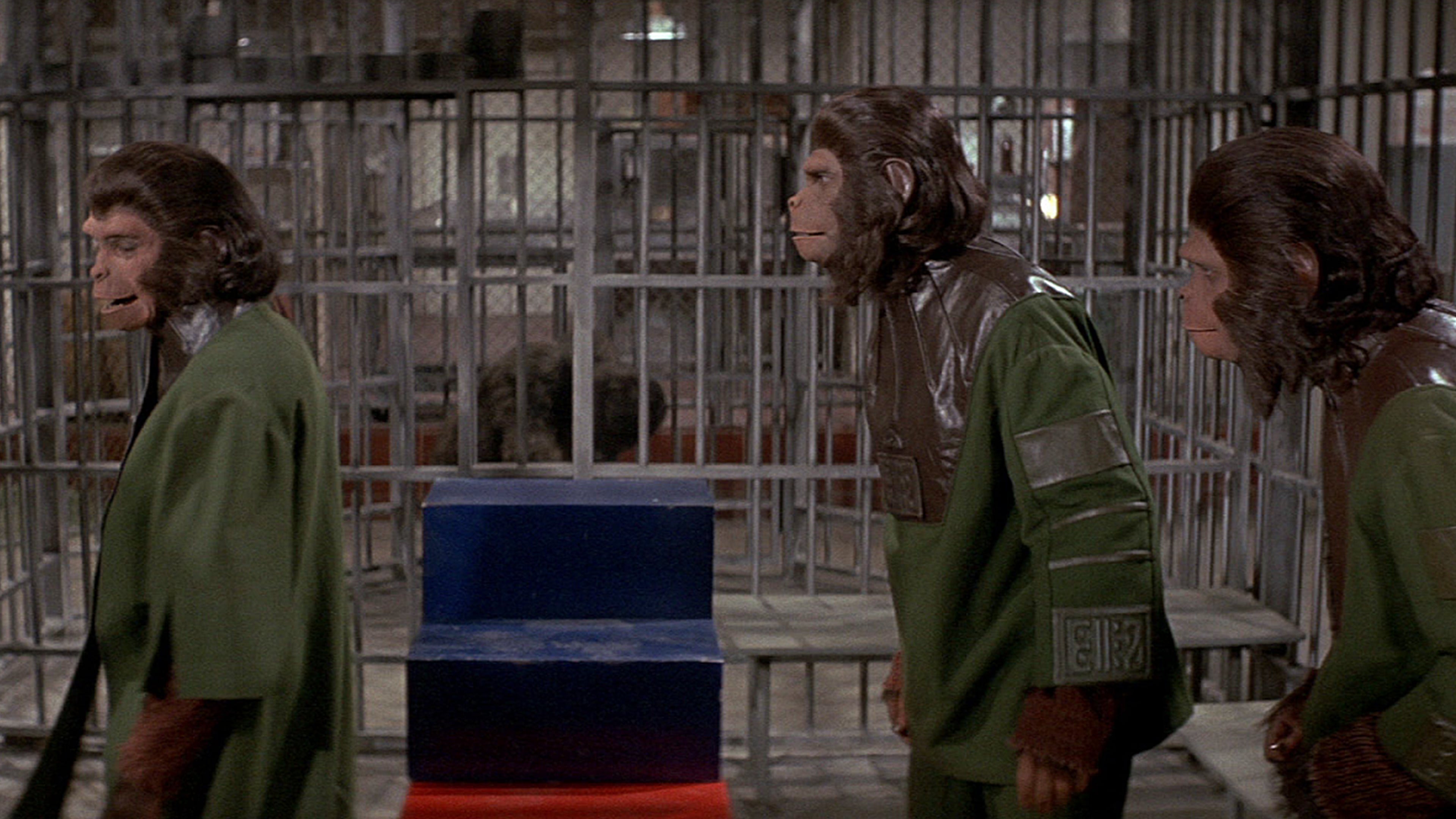
According to their accounts, a space-borne plague will kill dogs and cats almost to extinction. Humans then begin to take apes as pets, before turning the animals into slaves. Apes are intelligent enough to follow their masters’ orders, but they do not have the mental capacity to rebel. Centuries of enslavement make people lazier than ever, whereas the apes continue to learn the human language and acquire the ability to speak. The one chimpanzee to start the ape revolution is Caesar, the son of the time-travelling couple Dr. Zira and Dr. Cornelius. Caesar is born an evolved ape. It is a time travel paradox.
Michael Wilson’s script for the original Planet of the Apes includes a scene where Taylor and some primitive humans are held inside a laboratory. The captives are provided with building blocks as an experiment to see whether they can build a structure to reach a banana hanging from the ceiling. The scene is discarded but reused by Paul Dehn for the second sequel.
Dehn’s first draft also offers a hint about an already occurring ape evolution even before the arrival of Dr. Cornelius and Dr. Zira. The scene potentially creates a smooth and less farfetched transition between a human-dominated world to the gradual (as opposed to abrupt) development of ruling ape society. Either way, Escape from the Planet of the Apes sets the revolution in motion.
Main Cast and Crew
The second sequel puts the spotlight back on the apes. With an even bigger mixture of new and returning actors armed with a thought-provoking script, Escape from the Planet of the Apes becomes arguably the strongest of all four sequels to the original. Producer Arthur P. Jacobs’ decision to bring Don Taylor into the directorial seat proves to be an efficient choice. Keeping screenwriter Paul Dehn onboard is equally a smart move. Reprising their roles as the ape scientists Dr. Cornelius and Dr. Zira are Roddy McDowell and Kim Hunter. Charlton Heston, the lead actor in the first film, appears in a few brief flashback sequences.
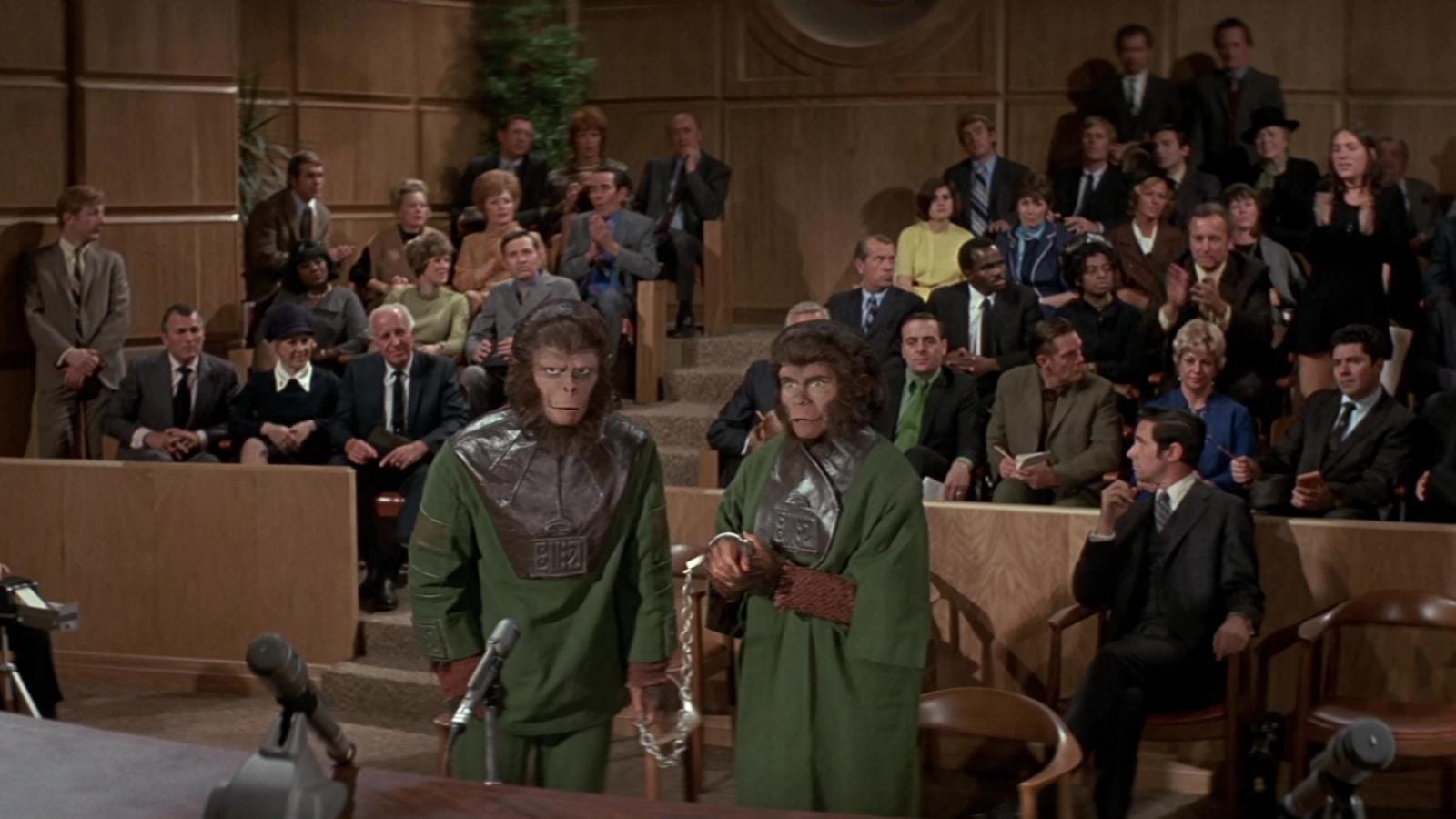
Dr. Lewis Dixon is portrayed by Bradford Dillman, whose performance as PFC Alan Newcombe in Love and War (1958) earned him a Golden Globe Award. Natalie Trundy, who portrays Dr. Stephanie Branton, also makes an appearance in the first sequel as Albina.
Have you seen the 1971 Escape from the Planet of the Apes? What do you think of it? Let us know. We’d love to hear from you.
Other things you might want to know:
How and when did producer Arthur P. Jacobs tell his writer to begin work on Escape from the Planet of the Apes?
About four months after the success of Beneath the Planet of the Apes, Jacobs simply sent screenwriter Paul Dehn a telegram which read, “Apes exist. Sequel required.”
How did the POTA movies do at the box office?
All five original “Planet of the Apes” movies were #1 at the U.S. box office when released. “Escape from the Planet of the Apes” spent one week as the #1 top-grossing film: the week of May 23, 1971, it made $4,294,942.
Which actors returned from previous POTA movies to star in Escape from the Planet of the Apes?
Actors – Escape from the Planet of the Apes (1971) Returning
Roddy McDowall returned as Cornelius. McDowall was covered in Planet of the Apes (1968).
Kim Hunter also returned as Zira. Hunter was covered in Planet of the Apes (1968).
M. Emmet Walsh played a military aide and actually got a few laughs. Walsh was covered in Back to School (1986).
Natalie Trundy played veterinarian Dr. Stephanie Branton. Trundy was covered in Beneath the Planet of the Apes (1970).
Ricardo Montalban played zoo owner Armando. Montalban was covered in Battleground (1949).
Robert Gunner as Landon was in uncredited archive footage from Planet of the Apes (1968).
Check out other articles by month:


